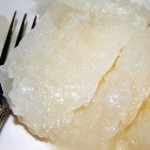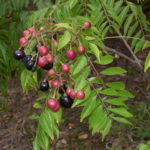By Catherine Haug; Jan-Feb 2007, updated in Aug 2007, and moved/updated to Cat’s Kitchen on Mar 30, 2021. [note: red text indicates updates/changes yet to be made]
See Diet and Health Menu under “Insulin Resistance, and Metabolic Syndrome” for list of my other articles about Insulin Resistance.
Insulin is an important, ancient hormone; it:
- signals the processes that move glucose into cells for energy production;
- causes any excess sugar to be stored in adipose (fat) cells as fat;
- suppresses glucagons and growth hormones, which regulate the burning of fat (and stored fat) and rate of muscle development, respectively.
Thus insulin acts as a double-edged sword in response to excess dietary carbs: insulin promotes storage of the excess carbohydrates as body fat, and then wards off the body’s ability to lose that fat. (7) For more, read on …
- Includes: 1. Insulin; 2. What Is Insulin Resistance? 3. Symptoms of Insulin Resistance; 4. Testing for Blood Insulin Level; 5. Metabolic Syndrome: What Happens When Insulin Sensitivity Goes Awry
- See also (this site): 1. Diet and Health Menu; 2. Notes on Insulin Resistance (IR); 3. Choline, Inositol, and Insulin Resistance; 4. Ketogenic Diet; 5. Cyclical Ketogenic Diet (CKD) and Metabolic Mitochondrial Therapy (MMT)
- Other Sites: 1. Mercola: What is Pre-diabetes (Insulin Resistance) [I want to update my post to include testing, etc info from Mercola’s article]; 2. Here’s an interesting study from Great Britain published in 2011. See BBC: Diabetes, Diet and Obesity; the study was published in Diabetologia: Reversal of type 2 diabetes: normalisation of beta cell function in association with decreased pancreas and liver triacylglycerol






